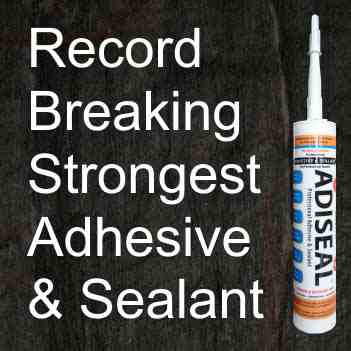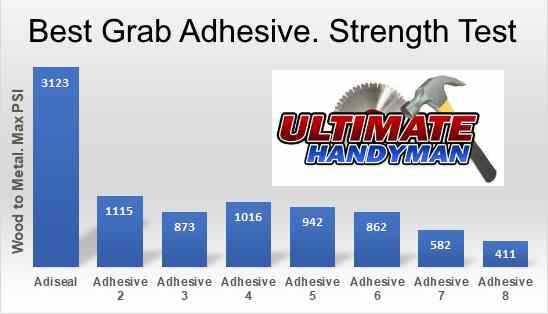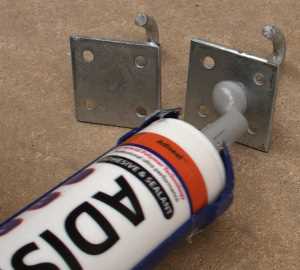How to Attach a Mirror to a Wall Without Nails
(Last Updated On: 24 September 2021)
To glue metal to wood, there are different glues & adhesives available in addition to mechanical fixings. In this article we will look at how to stick metal to wood together using an adhesive & why Adiseal is the best adhesive to bond and attach metal to wood.
There are many different products that will stick wood to metal, but to get a good strong long lasting bond, use the record breaking strongest Adiseal adhesive & sealant.

Why Adiseal is the best to glue metal to wood
Adiseal adhesive & sealant is the best product at sticking wood and metal together. In an independent wood to metal adhesive strength test by Ultimate Handyman, Adiseal was the strongest. It was over 3 times stronger than the nearest competitor in the wood to metal bond strength test. In fact it was so strong that the screws holding the metal sheet down started to rip out forcing the test on Adiseal to be stopped.
Strongest Wood to Metal Glue Test Results
- Adiseal : 3123 psi
- SupaBond : 1115 psi
- Tec 7 : 1016 psi
- HB42 : 942 psi
- Loctite PL Premium : 873 psi
- Gorilla Grab Adhesive : 862 psi
- Bond It PU18 : 582 psi
- Bond It Saves Nails : 411 psi
Some of the other reasons why Adiseal is the best when trying to to bond wood to metal:
- Adiseal is the record breaking strongest adhesive & sealant. It proved it's the best in an independent adhesive strength test by Ultimate Handyman.
- Adiseal stays permanently flexible so it will absorb any vibration and allow any items to expand & contract without the adhesive becoming weak.
- Adiseal is waterproof so it is also suitable for use outdoors or indoors.
- As long as the surface is clean of any dust, grease, paint or any other dirt, priming the material should not be required.
- Adiseal does not soak into wood so sealing of the wood is not required.
- Adiseal has very high gap fill properties.
- Adiseal has high initial grab meaning temporary supports may not be required while the adhesive cures. Adiseal Hi-Grab has even higher grab than the standard product.
- Adiseal is suitable for use of softwood, hardwood & all metals.

Problems with epoxy adhesives
There are several problems with using epoxy adhesives to glue metal to wood. Listed below are the some of the problems of epoxy adhesives.
- Although epoxy adhesives might initially bond wood to metal, epoxy adhesives are not flexible meaning the bond will become weaker over time. Air temperature & moisture changes cause items to expand & contract putting extra forces on an adhesive or glue. If the adhesive or glue is not flexible, it will become weak & brittle then eventually break. Wood is a material that is likely to soak up moisture in the air so likely to expand or contract. Metals are good heat conductors so are likely to expand & contract easily with temperature changes.
- Epoxy adhesives also come in 2 separate components which require mixing. To achieve optimum epoxy adhesive properties, the 2 components need to be the correct ratio therefore require careful measuring. They also need to be mixed thoroughly together. If these 2 are not done then the optimum properties of the epoxy may not be achieved.
- Epoxy adhesives have lower initial grab than Adiseal, meaning temporary supports will usually be required whilst the epoxy adhesive cures. This increases time & money with extra labour cost.
Problems with mastic adhesives
Just like epoxy, mastic adhesives also have many problems when being used as an adhesive to stick metal to wood. Listed below are the main problems of mastic adhesives.
- The main problem with mastic adhesive is that the bond is weak in the 1st place. A mastic adhesive might be suitable at sticking light items indoors but will fail at more heavy duty applications.
- Another problem with mastic adhesives are they are not waterproof. This means they are not suitable for use where there will be water like bathrooms, kitchens or outdoors.
- Just like epoxy, mastic adhesives are not flexible meaning the already weak bond will become weaker over time. This is especially a problem with wood as wood absorbs moisture in the air causing it to expand or contract.
- The initial grab of the mastic adhesive is also low meaning temporary supports will be required, increasing time & labour cost.
Problems with contact adhesives
Contact adhesives may be suitable in sticking light sheets to a surface but not suitable for more heavy duty applications. There are a number of problems with contact adhesives.
- Contact adhesives have low initial grab meaning temporary supports will be required until the adhesive has cured.
- Contact adhesives also has low gap fill meaning if there is a gap in certain places between the 2 surfaces of the items being bonded, the contact adhesive will not stretch between the 2 surfaces. This will create a much weaker bond as only in a few places where the surfaces are very close together will the adhesive successfully bond.
- Certain wood sheets like MDF or chip board tends to soak up liquid glues & adhesives. To use a liquid glue or adhesive on these wood sheets will require sealing the wood first.
Problems with using glue
Glues are generally suitable at sticking small items to smooth surfaces but not for more heavy duty applications like bonding wood to metal. For more heavy duty applications, a construction adhesive like Adiseal will be required. Glues have lower gap fill, initial grab, bond strength, flexibility & other problems compared to Adiseal adhesive & sealant when trying to stick metal to wood.
Certain wood sheets like MDF or chip board tends to soak up liquid glues & adhesives. To use a liquid glue or adhesive on these wood sheets will require sealing the wood first.

When attempting to attach wood to metal, preparing both the wood & metal is vital to achieving a good strong long lasting bond.
Preparation of metal
To prepare the metal surface, make sure the surface is clean of any dust, grease, oil, paint, rust or any other dirt. UltraLube is an ideal penetrating oil & lubricant that can help in removing rust. Adisolve is the ideal product at removing oil, grease, tar & other stubborn deposits.
Preparation of wood
To prepare the wood surface, make sure the surface is clean of any dust, grease, oil, paint or any other dirt. Adisolve is the ideal product at removing oil, grease, tar & other stubborn deposits.
Applying the glue or adhesive between wood & metal
Once both wood & metal surfaces are clean, they are ready for the glue or adhesive. Wood will absorb certain glue's or adhesives so therefore require sealing prior to applying the glue or adhesive. If Adiseal adhesive & sealant is used, then there is no need to seal the wood as Adiseal will not soak into the wood.
Try to make sure there are no big gaps between the surfaces where the adhesive will be applied. If there are any big gaps then either cut or file down the surface of the wood or metal so that they match closely when the wood & metal are put together.
With Adiseal simply apply the adhesive to either the wood or metal and push the metal and wood together. As Adiseal has high grab, temporary supports should not be required but if the item does start to slide down then place temporary supports to hold the items in place until the adhesive has cured. Adiseal usually takes 24 hours to 48 hours to fully cure, with curing times increasing in colder temperatures.
Tip: If bonding wood to metal where there is a chance of water, apply the adhesive in thin vertical strips. This allows any water to run down between the strips instead of building up on top of the adhesive. If there is a build up of water between the wood & metal, in cold temperatures it will turn to ice which expands putting additional forces on the adhesive.
Glue wood to metal with Adiglue
It is also possible to glue wood to metal using our Adiglue. Although Adiglue is less brittle than super glues, it is still not as flexible or strong as Adiseal adhesive & sealant.
Stick metal to wood with Adiseal Hi-Grab
The Adiseal Hi-Grab instant grab adhesive will also stick metal to wood. It has a higher initial grab than Adiseal adhesive & sealant. We however recommend the Adiseal adhesive & sealant when attaching metal to wood. The reason for this is because the Hi-Grab product is a very thick product. To push together the 2 items that need sticking together requires a lot bigger force if the Hi-Grab adhesive is between the items.
Frequently Asked Questions
Can you glue wood to metal?
To attach wood to metal, use the record breaking strongest adhesive, Adiseal. In an independent wood to metal adhesive strength test, Adiseal was over 3 times stronger than the nearest competitor. Make sure both surfaces are thoroughly clean before applying the adhesive.
What is the best glue for metal to wood?
The best product to use is the record breaking strongest Adiseal. In an independent wood to metal adhesive strength test, Adiseal was over 3 times stronger than the nearest competitor.
How to attach metal to wood without screws?
Adiseal will attach metal to wood without screws. In a wood to metal adhesive strength test, Adiseal was over 3 times stronger than the nearest competitor. Make sure both surfaces are thoroughly clean before applying the adhesive.
Will Adiseal stick all wood to all metals?
Yes Adiseal adhesive & sealant will stick all types of wood to all types of metals. Making sure both items are thoroughly clean will achieve the strongest bond.
How to Attach a Mirror to a Wall Without Nails
Source: https://adiseal.com/wood-to-metal/